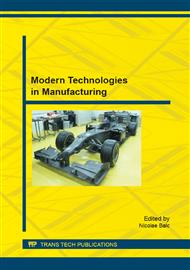p.169
p.175
p.181
p.187
p.193
p.199
p.205
p.213
p.221
Basic Research on Lattice Structures Focused on the Tensile Strength
Abstract:
This scientific survey is about the mechanical properties of lattice structures which are made by Selective Laser Melting. It’s a process based on Additive Manufacturing technologies. This technology allows the manufacturing of complex lattice structures, and further the integration of lattice structures into different applications. Focusing on the integration of these structures, it is necessary to know what kind of effect they have on applications and what positive properties they might support. More and more the industry searches for new supporting technologies and the trend is towards lightweight and material saving possibilities. [1, 2] A survey on this topic is indispensable. The main aim is to analyze different parameters that affect the mechanical properties. First of all the definition of the experimental set-up and the definition of the, to be tested, parameters are necessary. Furthermore the aim is to find several different parameters that have a positive effect on the mechanical properties. Above all the focus is on experimental set-ups that use mechanical tests, beginning with the test on tensile strength in accordance with DIN 50125. Depending on the results an application area could be chosen and assigned.
Info:
Periodical:
Pages:
193-198
Citation:
Online since:
November 2015
Authors:
Price:
Сopyright:
© 2015 Trans Tech Publications Ltd. All Rights Reserved
Share:
Citation:


